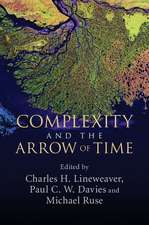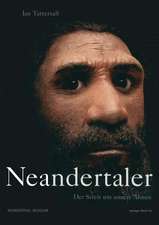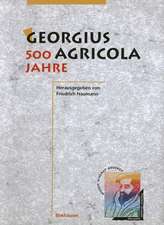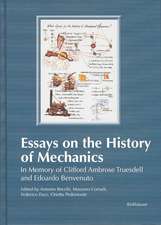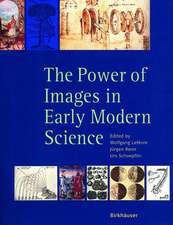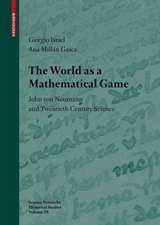The Biology of Numbers: The Correspondence of Vito Volterra on Mathematical Biology: Science Networks. Historical Studies, cartea 26
Autor Giorgio Israel, Ana M. Gascaen Limba Engleză Paperback – 13 noi 2012
| Toate formatele și edițiile | Preț | Express |
|---|---|---|
| Paperback (1) | 702.87 lei 6-8 săpt. | |
| Birkhäuser Basel – 13 noi 2012 | 702.87 lei 6-8 săpt. | |
| Hardback (1) | 709.25 lei 6-8 săpt. | |
| Birkhäuser Basel – 2002 | 709.25 lei 6-8 săpt. |
Din seria Science Networks. Historical Studies
- 18%
 Preț: 796.31 lei
Preț: 796.31 lei - 15%
 Preț: 652.49 lei
Preț: 652.49 lei - 18%
 Preț: 787.15 lei
Preț: 787.15 lei -
 Preț: 385.25 lei
Preț: 385.25 lei -
 Preț: 489.30 lei
Preț: 489.30 lei - 15%
 Preț: 476.75 lei
Preț: 476.75 lei -
 Preț: 389.31 lei
Preț: 389.31 lei - 15%
 Preț: 699.59 lei
Preț: 699.59 lei - 15%
 Preț: 660.37 lei
Preț: 660.37 lei - 15%
 Preț: 531.59 lei
Preț: 531.59 lei - 24%
 Preț: 909.27 lei
Preț: 909.27 lei -
 Preț: 396.24 lei
Preț: 396.24 lei - 18%
 Preț: 903.17 lei
Preț: 903.17 lei -
 Preț: 382.36 lei
Preț: 382.36 lei -
 Preț: 395.25 lei
Preț: 395.25 lei - 15%
 Preț: 647.73 lei
Preț: 647.73 lei - 15%
 Preț: 674.74 lei
Preț: 674.74 lei - 15%
 Preț: 655.60 lei
Preț: 655.60 lei - 15%
 Preț: 650.19 lei
Preț: 650.19 lei - 15%
 Preț: 644.82 lei
Preț: 644.82 lei - 15%
 Preț: 646.62 lei
Preț: 646.62 lei - 18%
 Preț: 1119.08 lei
Preț: 1119.08 lei - 18%
 Preț: 1135.46 lei
Preț: 1135.46 lei - 20%
 Preț: 595.48 lei
Preț: 595.48 lei - 20%
 Preț: 596.59 lei
Preț: 596.59 lei - 15%
 Preț: 649.06 lei
Preț: 649.06 lei - 20%
 Preț: 567.63 lei
Preț: 567.63 lei - 15%
 Preț: 639.37 lei
Preț: 639.37 lei -
 Preț: 399.12 lei
Preț: 399.12 lei - 18%
 Preț: 1390.11 lei
Preț: 1390.11 lei -
 Preț: 361.03 lei
Preț: 361.03 lei - 18%
 Preț: 1395.63 lei
Preț: 1395.63 lei - 15%
 Preț: 642.36 lei
Preț: 642.36 lei - 15%
 Preț: 648.24 lei
Preț: 648.24 lei - 15%
 Preț: 649.06 lei
Preț: 649.06 lei -
 Preț: 392.37 lei
Preț: 392.37 lei
Preț: 702.87 lei
Preț vechi: 826.91 lei
-15% Nou
Puncte Express: 1054
Preț estimativ în valută:
134.49€ • 140.43$ • 111.06£
134.49€ • 140.43$ • 111.06£
Carte tipărită la comandă
Livrare economică 15-29 aprilie
Preluare comenzi: 021 569.72.76
Specificații
ISBN-13: 9783034894470
ISBN-10: 3034894473
Pagini: 420
Ilustrații: IX, 405 p.
Dimensiuni: 155 x 235 x 22 mm
Greutate: 0.59 kg
Ediția:Softcover reprint of the original 1st ed. 2002
Editura: Birkhäuser Basel
Colecția Birkhäuser
Seria Science Networks. Historical Studies
Locul publicării:Basel, Switzerland
ISBN-10: 3034894473
Pagini: 420
Ilustrații: IX, 405 p.
Dimensiuni: 155 x 235 x 22 mm
Greutate: 0.59 kg
Ediția:Softcover reprint of the original 1st ed. 2002
Editura: Birkhäuser Basel
Colecția Birkhäuser
Seria Science Networks. Historical Studies
Locul publicării:Basel, Switzerland
Public țintă
ResearchCuprins
1 Mathematical Theories versus Biological Facts: A Debate on Mathematical Population Dynamics in the 30s (A. Millán Gasca) 1.- Correspondence.- 2 Vito Volterra.- 3 Presentation of the Correspondence.- 4 Letters between Marcel Brelot and Vito Volterra.- 5 Letters between Royal N. Chapman and Vito Volterra.- 6 Letters between Umberto D’Ancona and Vito Volterra.- 7 Letters between Charles S. Elton and Vito Volterra.- 8 Letter between Karl Friederichs and Vito Volterra.- 9 Letters between Georgii F. Gause and Vito Volterra.- 10 Letters between Samuel A. Graham and Vito Volterra.- 11 Letters between William O. Kermack and Vito Volterra.- 12 Letters between Vladimir A. Kostitzin and Vito Volterra.- 13 Letters between Joseph Larmor and Vito Volterra.- 14 Letters between Alfred J. Lotka and Vito Volterra.- 15 Letters between Edouard Monod-Herzen and Vito Volterra.- 16 Letters between Raymond Pearl and Vito Volterra.- 17 Letters between Karl Pearson and Vito Volterra.- 18 Letters between Jean Régnier and Vito Volterra.- 19 Letters between John Stanley and Vito Volterra.- 20 Letters between Georges Teissier and Vito Volterra.- 21 Letters between D’Arcy W. Thompson and Vito Volterra.- 22 Letters between William R. Thompson and Vito Volterra.- 23 Catalogue of Letters.- 24 References.
Recenzii
"The present book is an exhaustive collection of the correspondence between Vito Volterra and numerous scientists on the topic of Mathematical Biology. At the end of the book seventeen pages of very useful references are given. The book is useful to those who are working in the field of Mathematical Biology as well as History of Mathematical Biology."
—Zentralblatt Math
"We first meet Volterra on the front cover of the book under review. There he is: a magnificent, full-bearded and moustached figure in full academic regalia, shown perhaps in his mid-fifties. Vito Volterra, 1860–1940, professor at the University of Rome, president of the renowned Accademia dei Lincei, member of the Royal Society, recipient of other honors too numerous to mention, scion of an Italian Jewish family whose genealogy has been traced back to the early 1400s. A crater on the Moon has been named after him.... Reading the letters [in the book]...gives an idea of Volterra's extensive scientific contacts. More importantly, it gives an idea of the birth pangs of a relatively new and problematic application of mathematics. You will get whiffs of the struggles between the deterministic and the probabilistic approaches; between continuous and discrete models; among models in either category; between holistic (empirical and experimental) and mathematical approaches; between closed-form solutions and numerical solutions; between the qualitative and the quantitative. You will also read about the struggle between the realists and the idealists as regards what the goal of inquiry should be. Gasca's [54-page] introduction [to the book and history of the early (1920s and 30s) development of population dynamics] fleshes out these various antagonisms."
—SIAM News
—Zentralblatt Math
"We first meet Volterra on the front cover of the book under review. There he is: a magnificent, full-bearded and moustached figure in full academic regalia, shown perhaps in his mid-fifties. Vito Volterra, 1860–1940, professor at the University of Rome, president of the renowned Accademia dei Lincei, member of the Royal Society, recipient of other honors too numerous to mention, scion of an Italian Jewish family whose genealogy has been traced back to the early 1400s. A crater on the Moon has been named after him.... Reading the letters [in the book]...gives an idea of Volterra's extensive scientific contacts. More importantly, it gives an idea of the birth pangs of a relatively new and problematic application of mathematics. You will get whiffs of the struggles between the deterministic and the probabilistic approaches; between continuous and discrete models; among models in either category; between holistic (empirical and experimental) and mathematical approaches; between closed-form solutions and numerical solutions; between the qualitative and the quantitative. You will also read about the struggle between the realists and the idealists as regards what the goal of inquiry should be. Gasca's [54-page] introduction [to the book and history of the early (1920s and 30s) development of population dynamics] fleshes out these various antagonisms."
—SIAM News










